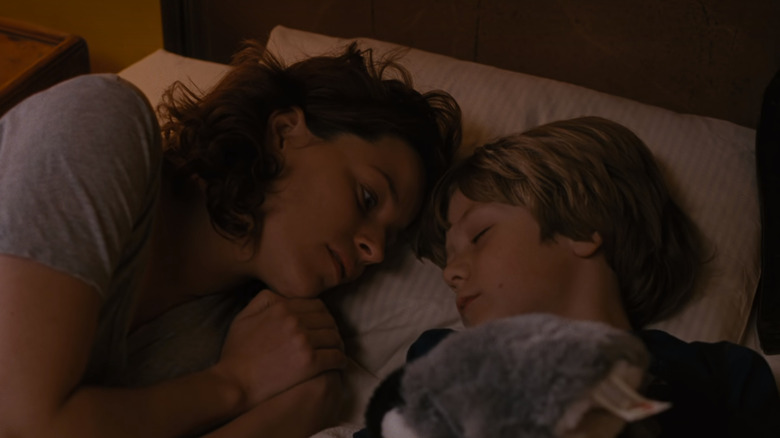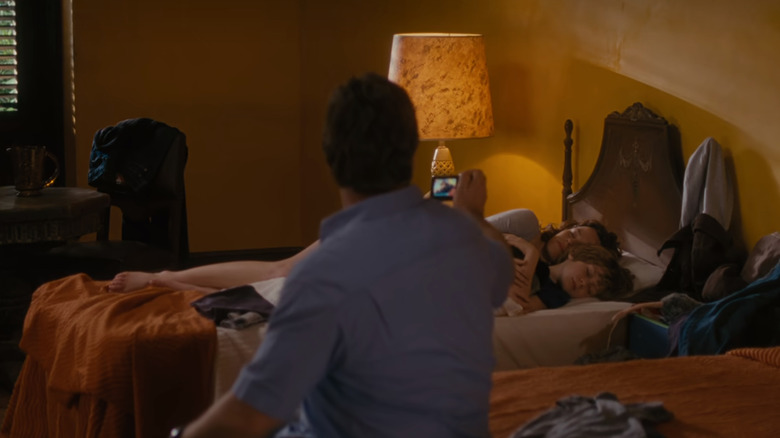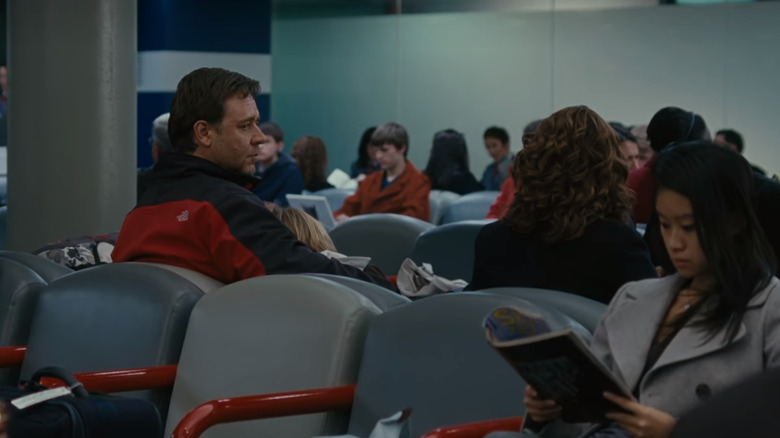The Ending Of The Next Three Days Explained
How far will a husband and father go to save his family? That is the central dilemma in 2010's "The Next Three Days," an action thriller directed by Paul Haggis. "The Next Three Days" is an American remake of a 2008 French action-thriller called "Anything for Her" ("Pour elle" in French). As suggested by the title, the French film follows a husband on his no-holding-back quest to free his wrongly convicted wife from prison. The main difference between the French and American versions of the story is the ambiguity of the wife's innocence injected into the American film.
A star-studded cast carries much of "The Next Three Days." Russell Crowe, most famous for his award-winning roles in "Gladiator" and "A Beautiful Mind," is the film's protagonist. Elizabeth Banks, known for acting in "Wet Hot American Summer" and directing "Cocaine Bear," rounds out the other leading role. Even heavy hitters such as Liam Neeson and Olivia Wilde play minor characters in this thriller. We're here to break down everything in "The Next Three Days," what the ending truly means, and what potential futures exist for the characters.
What you need to remember about the plot of The Next Three Days
John and Lara Brennan — played by Russell Crowe and Elizabeth Banks, respectively — start the movie as parents deeply in love. The first few scenes of the movie drive home just how happy their home life is: Lara Brennan insists on taking daily photographs of the family together to document how much they all love each other.
Their happy home ruptures after a police force barges into their home and arrests Lara for murdering her boss. Evidence mounts against Lara — she had argued with her boss earlier in the day, she had her boss's blood on her coat, her fingerprints were on the murder weapon (a fire extinguisher), and an eyewitness saw her driving away from the scene. All in all, despite her pleas that the criminal ran into her while escaping, there is too much evidence against her. John Brennan, her husband, never doubts her innocence for a second. With all legal avenues exhausted and Lara left with the finality of a life sentence, John takes matters into his own hands.
After some trial and error, John successfully acquires forged ID paperwork, learns how to use bump keys, tampers with his wife's medical documents, and familiarizes himself with all the patterns of security guards. His plan begins earlier than he wants when he learns that Lara is moving to a higher-security prison in three days.
What happens at the end of The Next Three Days
Ultimately, John's plan works out. There are close calls throughout the escape sequence, but John wins at the end of the day. He successfully breaks Lara out of prison, evades police long enough to pick up their child, and they make it to Caracas, Venezuela, to start life anew.
Throughout the film, doubt hangs over Lara's innocence. The first few scenes of her in the movie are a fiery back-and-forth with another colleague. It aims to serve the point that perhaps, Lara does have the potential to kill someone — despite how John sees her.
Flashback scenes in "The Next Three Days" show Lara's side of the story. In her version, the murderer bumped into Lara as they were exiting the scene, causing her to get blood on her coat while also, crucially, causing a button to pop off her jacket. Her claims that a button fell off would potentially prove another person at the crime scene, but investigators never found that button.
The final scenes of "The Next Three Days" have an investigator look again for the button Lara claimed she heard pop off her jacket. He successfully intuits that it washed down a drain during a rain storm, but he doesn't find the button when he lifts the grate and scrapes his hands along the rim. Only the audience sees that the button is actually there — corroborating Lara's innocence once and for all.
What does the end of The Next Three Days mean?
On its surface level, the ending of "The Next Three Days" confirms Lara's innocence and justifies the extremes John went to in order to save her. Ultimately, the justice system is proven incompetent, and the right thing for the characters to do in this instance is to supersede those societal limitations placed upon them.
John Brennan is a community college English professor characterized as self-absorbed, but with an idealistic nature. His lecture on "Don Quixote" encapsulates the themes at the film's end. In it, he describes how "Don Quixote" is a refutation of the tyranny of rationality — that those living in a reality of their own making, while perhaps insane, are better off than those living a life of rational despair.
Taken literally in the context of the movie's plot, John Brennan's philosophy prevails at the end. The "accepted reality" — substantiated by the legal system — is incorrect. Therefore, John's moral impetus to substitute his own reality, the one in which he fully trusts his wife's innocence, is correct. By the movie's end, John's endorsement of quixotic idealism proves to be the only driving force that delivers any actual justice.
Why does Lara attempt to jump out of the car during the escape?
One of the most memorable and surprising scenes of "The Next Three Days" is Lara's attempted foiling of the escape. John kept his plans secret from Lara for the three years she served in jail. During the development of his plan, Lara criticized John for his naive optimism, not sensing his intentions.
So when John springs the plan into action by taking doctors hostage without any knowledge on her part, she is very apprehensive. There is no big reunification scene. Instead, there is only tension between Lara and John as they escape the police chase.
John's plan requires him, Lara, and their child to be outside city limits within a specific time. When it becomes clear that there is not enough time left to pick up their child during the escape, John decides to leave him behind and return for him. Lara glares in disbelief, opens the car door while speeding down the expressway, and tries to eject herself from the vehicle. John saves her in dramatic, car-spinning fashion. He agrees afterward to go and get their kid, regardless of the plan.
In this scene, Lara proves she is willing to risk everything for her love of her child, similar to how John is willing to risk everything to save her. At the film's end, her child finally accepts her love, book-ending her act of dedication.
Why do the cops not find the button at the end?
In the movie's most pivotal scene, where novel information shines a light on the rest of the movie's events, only the audience ultimately participates in the revelation. If the cops found the button corroborating Lara's story at the end, what would that mean?
Most importantly, it would prove Lara's innocence, or potential innocence, in the eyes of the law. John and Lara's legitimacy in society's official, rational gaze would be restored. However, that theme would clash with the quixotic refutation of the accepted consensus that ultimately prevails in the movie. John's version of reality — the one he believes in and creates — is all the more justified precisely because the police are incapable of producing the correct events through rationality. The button in the drain at the end symbolizes the underlying truth of John's convictions, and the subsequent near miss of finding it reinforces his personal construction of reality as necessary and just.
What the end means for John Brennan
From the very start of John Brennan's plan to break his wife out of prison, the audience can tell he is in a bit over his head. After all, he is a community college English professor with no experience in the criminal underworld. However, by the movie's end, John goes from conned and beaten up by local bar thugs to outsmarting entire police forces. His success at the film's end somewhat justifies all the horrible things he had to do based on his drive and instinct to rescue his wife.
The ends justifying the means for John Brennan means that robbing the meth-lab drug dealer was worth it. Breaking, entering, and tampering with medical courier vans was worth it. Deceiving his parents and his child's best friend's mother was worth it. At the end of the day, John gets what he wants, even if he has to become something he didn't want to become.
Despite his success, though, John and his family will have to live in the shadow of their past for the rest of their lives. Liam Neeson's character, a prison-break expert, foreshadows this constant looking over shoulders to John at the film's beginning. John gets what he wants, but what price did he pay?
What the end means for Lara Brennan
In perhaps the most shocking turn of events around the midpoint of the movie, Lara Brennan admits to killing her boss to John after years of prison time. She tells John with venom and pity in her voice that he has the wrong idea of her — that she is guilty. He doesn't believe it for a second, tells her so, and presses forward with his plan.
The movie's ending — showing the audience the true flashback sequence with the coat button in the storm drain — emphatically insists on her innocence. So why would Lara lie to John about killing her boss? Perhaps it is because she has too much self-hatred and loathes how John is dedicating his life to what she believes is a lost cause.
Whatever the reason, the ending of the movie signifies that moment as a low point for Lara. It also shows her broken up about their family's lost potential, despite knowing she was wrongfully convicted. Her faithfulness to her family unit, as signified by her almost jumping out of the car during the escape in protest of leaving their child behind, pays off when all of them end up together.
Did John's father know he was planning the escape?
A constant theme throughout the movie is the idea of following personal truth. All corroborating evidence tests John's resolve in the belief of his wife's innocence time and again. Even his parents do not quite believe in Lara's innocence — after all, the evidence overwhelmingly points to her at the scene of the crime, holding the weapon with the victim's blood on her.
John's father is a taciturn fellow who grunts his greetings and keeps to himself. He and John have a strained relationship, with neither showing much love to the other throughout. However, he is the only person with any suspicion of John.
At the movie's end, when John successfully escapes his family to Venezuela, his father pulls out a World Atlas and smiles when he opens the page on South America. He also covers for John when questioned by the police, saying that they hadn't spoken recently when, in reality, they had just said their final goodbyes a few days prior. During that goodbye scene, John's father knows what the goodbye means: a final goodbye. All in all, John's father almost certainly knew John was planning some escape for his family, and by not saying anything, like his usual taciturn self, he helped and condoned the escape.
What Russell Crowe had to say about The Next Three Days' ending
As the film's protagonist, the ending potentially has the most meaning for John Brennan. It provides closure to the romantic construction of his own reality. It justifies his actions that he would have thought impossible of himself before the story's events. It also asks how much John Brennan paid — what parts of his soul were changed — by his actions?
In a video interview with CriticsChoiceMovies about his understanding of his role in the movie, Russell Crowe said, "There is an undying love — where a man will do anything for his wife — and the conundrum to achieve what he achieves is that he has to turn into somebody that his wife couldn't love." Here, Crowe is picking up on the theme of the ends justifying the means.
For John Brennan, this creates a tough dilemma. Throughout the film, he attempts to have his cake and eat it too. He needs cash, so he robs a drug dealer. But during the robbery, he shows empathy to the drug dealer and nearly dies because of it. This type of soul-hardening experience — being willing to push a nice old lady out of the way, as Liam Neeson's character puts it at the start of the movie — irrevocably changes John Brennan. As Crowe stated, the person he is at the end of the movie isn't quite the same person his wife fell in love with.
What Paul Haggis had to say about The Next Three Days' ending
Paul Haggis, mostly known for being the Oscar-winning director of "Crash" and screenwriter of "Million Dollar Baby," stepped out of his wheelhouse for this action thriller. In an interview with Script Magazine, Haggis compared the scope of his adaptation to the original French film, "Anything for Her."
He said, "In the French film, they escape, they're happy, it's fine. In my film, when they escape, there's no big kissing scene — she walks by him very tenderly and looks at him and tries to smile, and then they're in separate beds." Haggis specifically added elements of doubt to Lara's innocence and imperfections within the Brennans' relationship for this type of reunification scene to successfully resolve tension despite not quite reaching the happily-ever-after motif.
Furthermore, he stated, "The audience sees the ending and they see him taking a photograph and they think, 'Aw, isn't that sweet? It reflects the photograph from the beginning.' But the photograph at the beginning had three people. In this one, there are two people. So he got what he wanted, he reunited his wife and his son, but at what cost?" At the end of the day, Haggis clearly states that while the film has a "happy ending," everything isn't neatly resolved. The law still considers them criminals, and their family still needs rebuilding.
What audiences and critics have said about The Next Three Days' ending
Overall, according to Rotten Tomatoes, "The Next Three Days" received a lukewarm reception from both audiences and critics. It sits at a 50% critic score and a 66% audience score (with over 50,000+ audience reviews).
In particular, some fans took issue with the somewhat silly implication of the ending. Redditor u/david-saint-hubbins posted, "Enjoyable movie, though the reveal at the end of how Elizabeth Banks essentially accidentally framed herself for the murder was a bit ridiculous."
Roger Ebert's review similarly criticized the movie's ending and use of flashbacks. He said, "There are indistinct black-and-white flashback scenes that are ambiguous. They raise the possibility. I consider them cheating: A movie knows whodunit. If it includes scenes that deliberately mislead us and then later clears up our confusion, that's a form of cheating, and the movie knows it." Clearly, how Lara's innocence resolves at the movie's end left some viewers wanting more.
Will there be a sequel to The Next Three Days?
There have been no confirmed reports of a sequel in the works for 2010's "The Next Three Days," but that has not stopped some fans from asking for one. The film's not-so-happily-ever-after leaves much room for the story's potential continuation.
A sequel could answer some burning questions: How does Lara reconnect with her child after he has only known her locked away? How do John and Lara rebuild their relationship? Will the Brennans ever escape the shadow of their past because the button was not found? What will John do with all his newly acquired skills? Why was Lara's boss murdered in the first place, and who did it? It is a testament to good writing that all these questions remain unanswered even after a happy resolution. In many ways, the bittersweet taste at the end of the movie, as opposed to a pure feel-good ending, allows space for all these unresolved questions to linger. While unlikely at this point, perhaps someday, audiences will know what happens after the titular "The Next Three Days."












